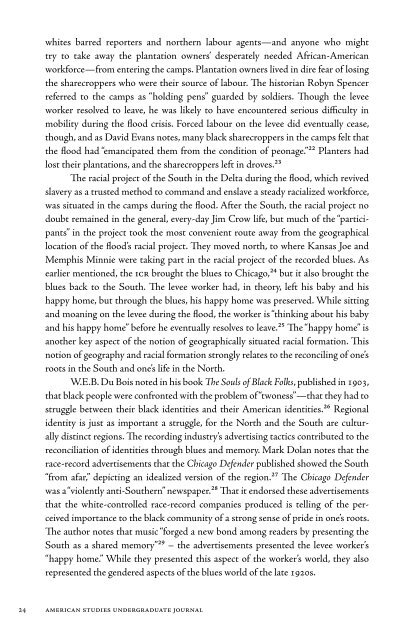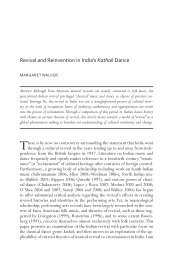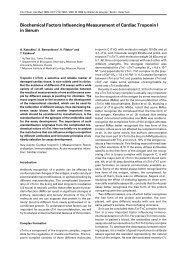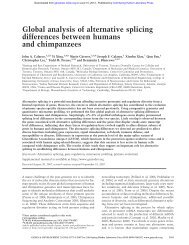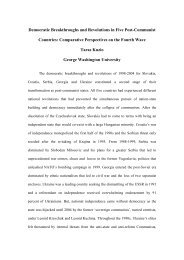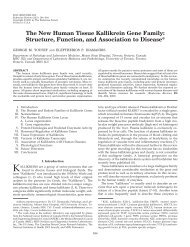AMERICAN STUDIES - University of Toronto
AMERICAN STUDIES - University of Toronto
AMERICAN STUDIES - University of Toronto
Create successful ePaper yourself
Turn your PDF publications into a flip-book with our unique Google optimized e-Paper software.
whites barred reporters and northern labour agents—and anyone who might<br />
try to take away the plantation owners’ desperately needed African-American<br />
workforce—from entering the camps. Plantation owners lived in dire fear <strong>of</strong> losing<br />
the sharecroppers who were their source <strong>of</strong> labour. The historian Robyn Spencer<br />
referred to the camps as “holding pens” guarded by soldiers. Though the levee<br />
worker resolved to leave, he was likely to have encountered serious difficulty in<br />
mobility during the flood crisis. Forced labour on the levee did eventually cease,<br />
though, and as David Evans notes, many black sharecroppers in the camps felt that<br />
the flood had “emancipated them from the condition <strong>of</strong> peonage.”22 Planters had<br />
lost their plantations, and the sharecroppers left in droves.23<br />
The racial project <strong>of</strong> the South in the Delta during the flood, which revived<br />
slavery as a trusted method to command and enslave a steady racialized workforce,<br />
was situated in the camps during the flood. After the South, the racial project no<br />
doubt remained in the general, every-day Jim Crow life, but much <strong>of</strong> the “participants”<br />
in the project took the most convenient route away from the geographical<br />
location <strong>of</strong> the flood’s racial project. They moved north, to where Kansas Joe and<br />
Memphis Minnie were taking part in the racial project <strong>of</strong> the recorded blues. As<br />
earlier mentioned, the ICR brought the blues to Chicago,24 but it also brought the<br />
blues back to the South. The levee worker had, in theory, left his baby and his<br />
happy home, but through the blues, his happy home was preserved. While sitting<br />
and moaning on the levee during the flood, the worker is “thinking about his baby<br />
and his happy home” before he eventually resolves to leave.25 The “happy home” is<br />
another key aspect <strong>of</strong> the notion <strong>of</strong> geographically situated racial formation. This<br />
notion <strong>of</strong> geography and racial formation strongly relates to the reconciling <strong>of</strong> one’s<br />
roots in the South and one’s life in the North.<br />
W.E.B. Du Bois noted in his book The Souls <strong>of</strong> Black Folks, published in 1903,<br />
that black people were confronted with the problem <strong>of</strong> “twoness”—that they had to<br />
struggle between their black identities and their American identities.26 Regional<br />
identity is just as important a struggle, for the North and the South are culturally<br />
distinct regions. The recording industry’s advertising tactics contributed to the<br />
reconciliation <strong>of</strong> identities through blues and memory. Mark Dolan notes that the<br />
race-record advertisements that the Chicago Defender published showed the South<br />
“from afar,” depicting an idealized version <strong>of</strong> the region.27 The Chicago Defender<br />
was a “violently anti-Southern” newspaper.28 That it endorsed these advertisements<br />
that the white-controlled race-record companies produced is telling <strong>of</strong> the perceived<br />
importance to the black community <strong>of</strong> a strong sense <strong>of</strong> pride in one’s roots.<br />
The author notes that music “forged a new bond among readers by presenting the<br />
South as a shared memory”29 – the advertisements presented the levee worker’s<br />
“happy home.” While they presented this aspect <strong>of</strong> the worker’s world, they also<br />
represented the gendered aspects <strong>of</strong> the blues world <strong>of</strong> the late 1920s.<br />
Through the shift in the race-record advertisements’ focus from female to<br />
male performers by the end <strong>of</strong> the 1920s, the advertisements account for a redefinition<br />
<strong>of</strong> gender relationships in the blues, which the dual guitars in “When the<br />
Levee Breaks” characterize. In her discussion <strong>of</strong> gender as an analytical tool, Joan<br />
Scott identifies one notion <strong>of</strong> “gender” as a “constitutive element <strong>of</strong> social relationships<br />
based on perceived differences between the sexes, which were a primary way<br />
<strong>of</strong> signifying relationships <strong>of</strong> power.”30 The blues scene was male-centred by the<br />
end <strong>of</strong> the 1920s, and Memphis Minnie strongly defined and solidified her position<br />
in it by both confusing and validating the perceived differences that separated<br />
“woman’s” blues from “men’s” blues. Mamie Smith’s “Crazy Blues”, the first blues<br />
recording in 1920, is known as “classic blues,” which was decidedly different from<br />
the “country blues” that gained popularity in the mid 1920s. Classic blues had a<br />
large female presence, and they were primarily singers who performed a sort <strong>of</strong><br />
vaudeville blues with instrumental backup. After the mid-1920s, women’s place in<br />
the newly dominant country blues became uncommon. Country blues musicians<br />
were <strong>of</strong>ten self-accompanied male singers and guitar or harmonica players.31<br />
Country blues musicians considered their form <strong>of</strong> the blues to be the “real<br />
folk blues,” and derided classic blues as inauthentic because <strong>of</strong> its vaudeville style.32<br />
However, Charles Marcus Tribbett, in his analysis <strong>of</strong> Memphis Minnie’s blues,<br />
argues that it was rather because classic blues was female-oriented that blues<br />
musicians did not consider it authentic. That ads for blues from female musicians<br />
virtually disappeared from the Chicago Defender by mid-decade lends credence to<br />
Tribbett’s argument. The blues scene was changing, and it had been appropriated<br />
by men who were identified as true blues musicians.<br />
The lyrics and vocals <strong>of</strong> “When the Levee Breaks” have already been discussed<br />
in this essay in reference to labour, movement, and race relations, but it<br />
is the song’s musical form that speaks, or rather, plays to the notion <strong>of</strong> blues and<br />
gender because <strong>of</strong> the relationship between the two guitar parts. These two guitar<br />
parts—the strumming and the picking—are distinct yet complementary, with the<br />
picking taking a clear lead over the strumming, making it the dominant instrumental<br />
sound in the song, and equal to, if not more prominent than, the vocals. One<br />
could assume that Kansas Joe was playing the lead guitar part because <strong>of</strong> the male<br />
vocals, but most importantly because <strong>of</strong> the classic blues normal <strong>of</strong> male musicianship.<br />
However, there is no doubt Memphis Minnie was playing the lead guitar,<br />
because <strong>of</strong> her reputation as a skilled fingerpicking player. In fact, it is this style<br />
<strong>of</strong> guitar playing that gained her credibility in the classic blues scene. A frequently<br />
cited anecdote about Memphis Minnie comes from the blues musician William<br />
“Big Bill” Broonzy, who said, after another woman claimed she was Minnie, “Hell,<br />
no, that’s not Memphis Minnie, because the real Memphis Minnie can pick a guitar<br />
and sing as good as any man I’ve ever heard. This woman plays like a woman<br />
24 American studies undergraduate journal American studies undergraduate journal 25


